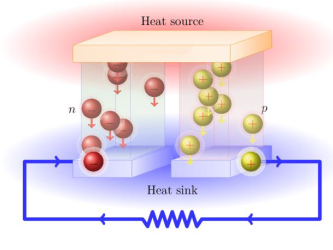Anyone who has ever flown on a Boeing 787 has seen this at work. The electrochromic (I suspect) window shades use power generated by a device that reside in the cold outside the airframe as well as the relatively warm environment inside, using that temperature difference.
Rich Kennedy
Electrical Engineer Emeritus
Unlicensed Spectrum Advocates, LLC
rkennedy1000@xxxxxxxxx
+1 (737) 202-7014
From: 徐伟杰 <00001bc427594473-dmarc-request@xxxxxxxxxxxxxxxxx>
Sent: Tuesday, August 16, 2022 9:07 PM
To: STDS-802-11@xxxxxxxxxxxxxxxxx
Subject: Re: [STDS-802-11] AMP TIG Question
--- This message came from the IEEE 802.11 Working Group Reflector ---
Hi, Steve,
You have mentioned an interesting application😊.
The heat energy harvester utilizes the seebeck effect (as shown in the following Figure)to convert heat to electric energy. The ouput power can range from 25~1000 uw per cm2. The condition where the energy harvester can work and generate power is that: there is temperature difference. That is to say, when there is temperature difference between the two ends of the energy harvester, energy can be generated and harvested.

For the data center application, as far as know, the indoor temperature will be kept almost constant (e.g., the fluctuation of the temperature is less than 1 centigrade ) using e.g., air conditioner in order to provide a good working condition for the servers. This appears to be one downside to use heat for energy harvesting. But on the other hand, may be it is still possible by attaching the energy harvester near the thermovent of the server. Hence, on one side of the energy harvester the temperature is higher and on the other side facing the indoor environment, the temperature is lower.
If is possible, may be some filed test can be done to verify this😊
In addition, as far as I know, heat energy harvester can be used in many scenarios: wearables ( to use the temperature difference between the body and the environment ), pipe monitoring (to use the temperature difference between the pipe and the environment and also the change of the environment temperature ), power transformation equipment, etc.
BR,
weijie
发件人: Steve Shellhammer <sshellha@xxxxxxxxxxxxxxxx>
发送时间: 2022年8月17日 8:37
收件人: STDS-802-11@xxxxxxxxxxxxxxxxx
主题: [STDS-802-11] AMP TIG Question
--- This message came from the IEEE 802.11 Working Group Reflector ---
AMP TIG,
This morning on the AMP TIG call someone (I do not recall who) mentioned that heat transfer is a method of energy harvesting.
Also, Harry made a nice presentation on Data Centers. And we know that in Data Centers there is typically lots of heat generated.
I wanted to know if someone knows whether it is possible to put a device somewhere on Servers in the Data Centers and can use the Heat for Energy Harvesting.
It would be interesting to hear if something like that is possible.
Regards,
Steve
To unsubscribe from the STDS-802-11 list, click the following link: https://listserv.ieee.org/cgi-bin/wa?SUBED1=STDS-802-11&A=1
OPPO
本电子邮件及其附件含有OPPO公司的保密信息,仅限于邮件指明的收件人使用(包含个人及群组)。禁止任何人在未经授权的情况下以任何形式使用。如果您错收了本邮件,请立即以电子邮件通知发件人并删除本邮件及其附件。
This e-mail and its attachments contain confidential information from OPPO, which is intended only for the person or entity whose address is listed above. Any use of the information contained herein in any way (including, but not limited to, total or partial disclosure, reproduction, or dissemination) by persons other than the intended recipient(s) is prohibited. If you receive this e-mail in error, please notify the sender by phone or email immediately and delete it!
To unsubscribe from the STDS-802-11 list, click the following link: https://listserv.ieee.org/cgi-bin/wa?SUBED1=STDS-802-11&A=1
To unsubscribe from the STDS-802-11 list, click the following link: https://listserv.ieee.org/cgi-bin/wa?SUBED1=STDS-802-11&A=1